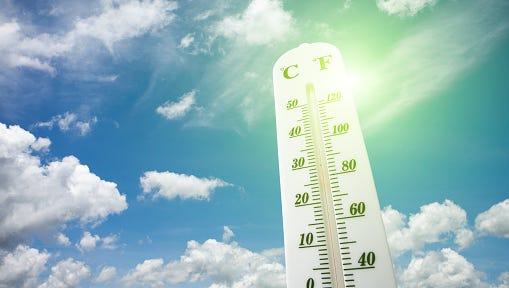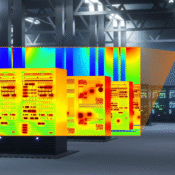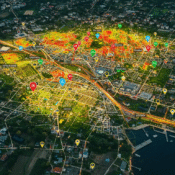In modern warehousing and industrial storage environments, maintaining consistent temperature conditions is critical for preserving product quality and optimizing energy performance. However, even in the most advanced facilities, temperature is rarely uniform. Subtle variations, known as microclimates, can create hidden hot and cold zones that impact both product stability and operational efficiency. This is where temperature mapping studies play a vital role in understanding and managing these fluctuations.
At Eximia360 (www.Eximia360.com), we specialize in conducting precise temperature mapping studies across Saudi Arabia, including Jeddah, Dammam, and Riyadh, to help businesses identify temperature inconsistencies and improve their storage facility performance.
What is Microclimate Temperature Mapping?
Microclimate temperature mapping is a specialized temperature mapping study designed to detect temperature variations within different areas of a storage facility. In large warehouses, cold rooms, or pharmaceutical storage centers, temperature can vary due to factors such as air circulation, insulation quality, door openings, equipment placement, and even sunlight exposure.
These variations, although sometimes small, can significantly affect product stability—especially for temperature-sensitive goods like food, chemicals, and pharmaceuticals. By conducting a detailed temperature mapping study, facilities can identify these microclimates and take corrective actions to maintain uniform environmental conditions.
Why Microclimate Mapping Matters in Saudi Arabia
Saudi Arabia’s climate poses unique challenges for controlled storage environments. With temperatures soaring above 45°C in summer, maintaining a stable indoor temperature requires careful system design and continuous validation.
Facilities in Riyadh, Jeddah, and Dammam often experience external heat infiltration and cooling system imbalances that lead to localized temperature differences. A temperature mapping study helps pinpoint these areas, ensuring that the entire facility meets compliance requirements and maintains product safety.
At Eximia360, we use advanced data logging equipment and wireless sensors to perform detailed temperature mapping studies, identifying even the smallest microclimatic variations that might affect product quality or energy efficiency.
How Temperature Mapping Studies Are Conducted
A professional temperature mapping study involves several key steps:
- Planning and Setup – The facility layout is reviewed to determine optimal sensor placement across various zones—such as storage racks, entry points, and HVAC outlets.
- Data Collection – Sensors record temperature and humidity levels continuously for a defined period, usually between 24 and 72 hours.
- Analysis and Visualization – The collected data is analyzed to generate temperature distribution maps that reveal hot and cold spots within the facility.
- Reporting and Recommendations – The findings are compiled into a detailed report, highlighting problem areas and suggesting improvements for air circulation, insulation, or equipment performance.
Through this systematic approach, temperature mapping studies provide data-driven insights that help companies in Saudi Arabia enhance both compliance and efficiency.

The Impact of Microclimate Mapping on Energy Performance
In addition to product safety, temperature mapping studies contribute significantly to energy optimization. Identifying uneven cooling or heating zones allows facilities to adjust HVAC settings, reduce energy wastage, and extend the lifespan of refrigeration systems.
For example, if a temperature mapping study reveals that one corner of a cold room consistently runs warmer than others, this could indicate poor airflow or equipment inefficiency. Correcting this issue not only protects stored goods but also lowers energy costs—a major advantage in large-scale Saudi storage operations.
At Eximia360, our temperature mapping study solutions combine real-time monitoring technology with advanced analytics, giving clients actionable insights to fine-tune their climate control systems and maintain operational excellence.
Benefits of Microclimate Temperature Mapping
- Enhanced Product Stability: Prevents spoilage or degradation due to unnoticed temperature fluctuations.
- Regulatory Compliance: Ensures adherence to standards like WHO, GMP, and GDP.
- Operational Efficiency: Improves HVAC system performance and reduces energy consumption.
- Predictive Maintenance: Identifies potential equipment failures before they occur.
- Data-Driven Decision Making: Provides detailed insights for future infrastructure upgrades.
Conclusion
Microclimate temperature mapping is a powerful tool for understanding the unseen temperature variations within large storage facilities. In a country like Saudi Arabia, where extreme climate conditions challenge storage stability, conducting regular temperature mapping studies is essential for maintaining quality, safety, and efficiency.
At Eximia360 (www.Eximia360.com), we are committed to helping businesses in Riyadh, Jeddah, Dammam, and across Saudi Arabia achieve precise environmental control through accurate and reliable temperature mapping studies. By identifying hidden microclimates and optimizing energy performance, we ensure your storage operations remain efficient, compliant, and ready to meet global standards.













